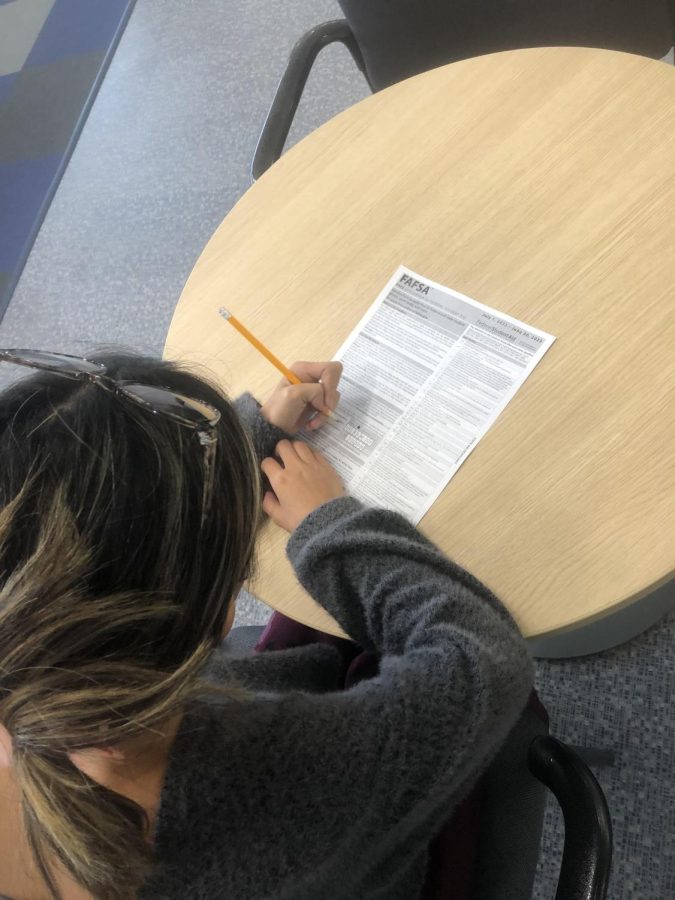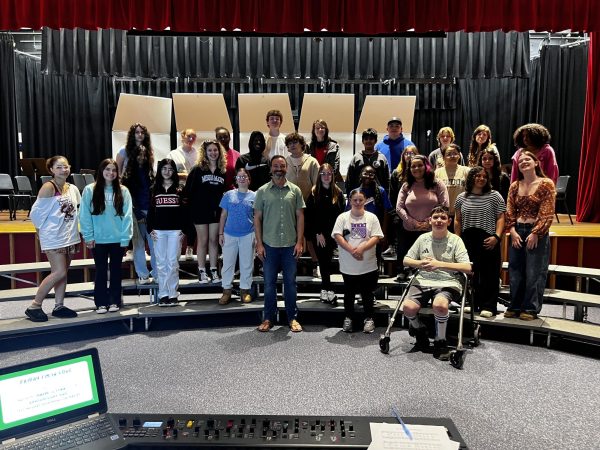Forget the Debt
Money is the Best Policy, Not Honesty
Applying for Aid: Senior Riley Grunow filling out the FAFSA, which is the Free Application for Federal Student Aid, September 22, 2022.
On Aug. 24, President Biden announced his policy for student loan forgiveness. College graduates who borrowed money to pay off their student debt are now eligible for forgiveness, meaning some of their debt will be erased. Those in need can earn up to $10,000 in student loan forgiveness.
Biden gave his speech the next day, Aug. 25, at the White House, where he officially announced this policy. His initial remarks consisted of how far the nation has come in terms of education. He then transitioned to discussing how the price of education beyond high school has gone up significantly.
Biden stated, “But here’s the deal: The cost of education beyond high school has gone up significantly. The total cost to attend a public four-year university has tripled — nearly tripled in 40 years — tripled.”
According to a fact sheet released by the White House, Biden plans to initiate a three-part plan to recover from financial stress placed on middle-class families because of the recent pandemic. The first and most important part includes targeted debt relief for students.
Biden added, “The Department of Education will provide up to $20,000 in debt cancellation to Pell Grant recipients with loans held by the Department of Education, and up to $10,000 in debt cancellation to non-Pell Grant recipients.”
The sheet describes eligibility and is determined by yearly income. It also describes that high-income earning individuals or couples will not benefit from the policy, again reinforcing that this is truly for middle-class working families.
Biden continued, “Borrowers are eligible for this relief if their individual income is less than $125,000 ($250,000 for married couples). No high-income individual or high-income household – in the top 5% of incomes – will benefit from this action.”
The second and third part of Biden’s forgiveness plan is to make the system of student loans more manageable by making the loan process simpler and easier to manage for current and future students, as well as attempting to protect future undergraduate students and taxpayers by lowering the cost of college as a whole.
The White House sees four events occurring, provided that all eligible students claim their forgiveness. First, they hope to deliver relief for up to 43 million students, 20 million of said students would have zero owed dollars afterwards. Second, they want to focus relief to low to middle-class students who are currently in debt. Third, they would like to support students of all ages, as more than a third of current students in debt are 40 years old or older. Lastly, they want to promote racial equity, since many students in debt are people of color.
There is also the debate of whether this will truly help college costs in the long-term, or whether a one-time forgiveness is the most efficient way to maintain student debt. Ms. Wunder, college and career specialist here at Foran, believes that it won’t help in the long run.
“What I can say is that I think college has gotten much too expensive. I do not believe that this policy is going to help the cost of college in the long run, but I am happy for the students who are getting some relief. If I am understanding the policy correctly this is a one-time forgiveness.”
Another issue is whether or not this is fair to those who have already paid off their debts, with no provided forgiveness, and also if $10,000 is even enough for those in debt. Mr. Rosengrant, a school counselor who is an expert in the process of applying to college, has a more positive outlook on fairness.
“To me, it’s not unfair. I was once told it’s never too late to do the right thing. Anything that is addressing peoples’ ability, or inability, to access education is a good thing and just because I may or may not benefit from current policies or legislature doesn’t mean it’s not the right thing to do,” he says.
Your donation will support the student journalists of Foran High School. Your contribution will allow us to purchase equipment and cover our annual website hosting costs.

Hi, my name is Luke Cruz, and I am a junior. I am a part of the football team, basketball team and track team. When I am not in school, I enjoy...







